七年级英语下册(冀教版2024)Unit 6 Being active Lesson 2 同步课时讲练(含答案)
文档属性
| 名称 | 七年级英语下册(冀教版2024)Unit 6 Being active Lesson 2 同步课时讲练(含答案) |
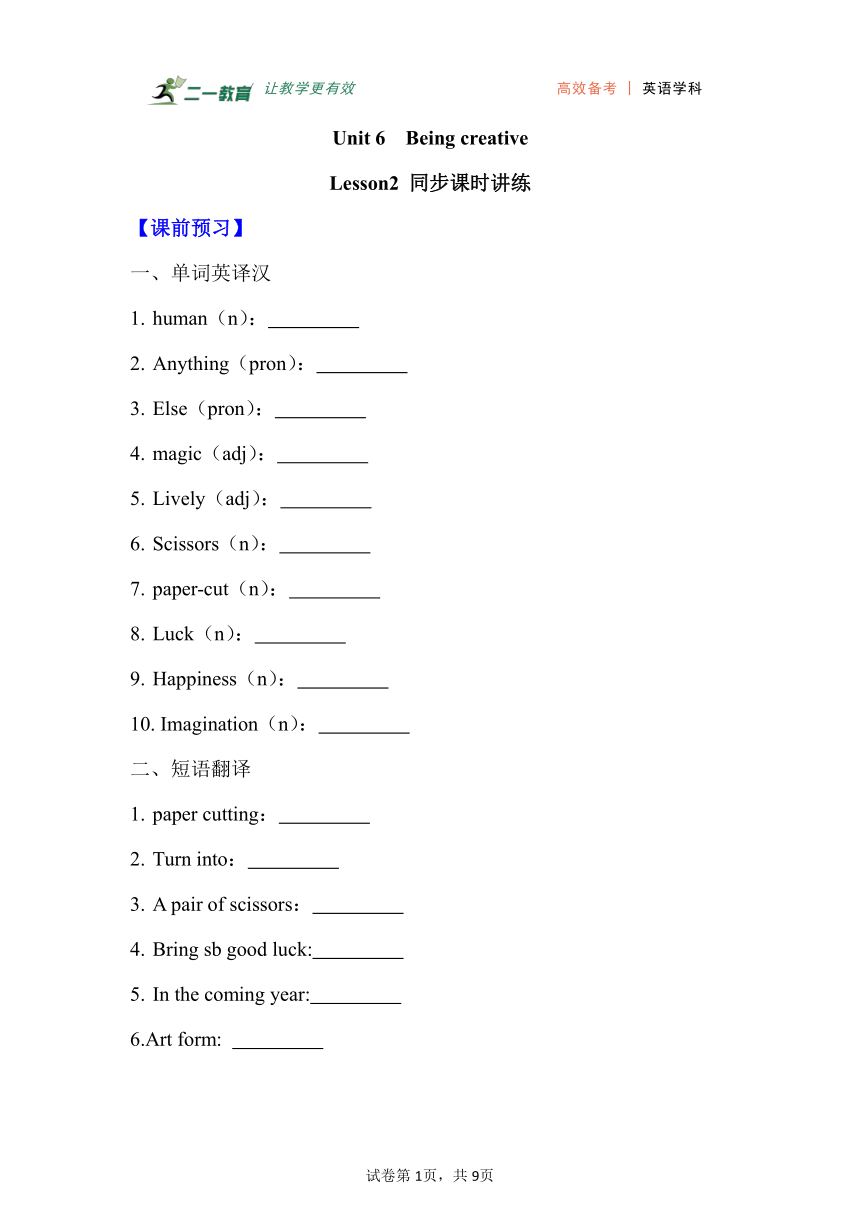
|
|
| 格式 | docx | ||
| 文件大小 | 56.6KB | ||
| 资源类型 | 试卷 | ||
| 版本资源 | 冀教版 | ||
| 科目 | 英语 | ||
| 更新时间 | 2025-05-06 12:47:31 | ||
图片预览

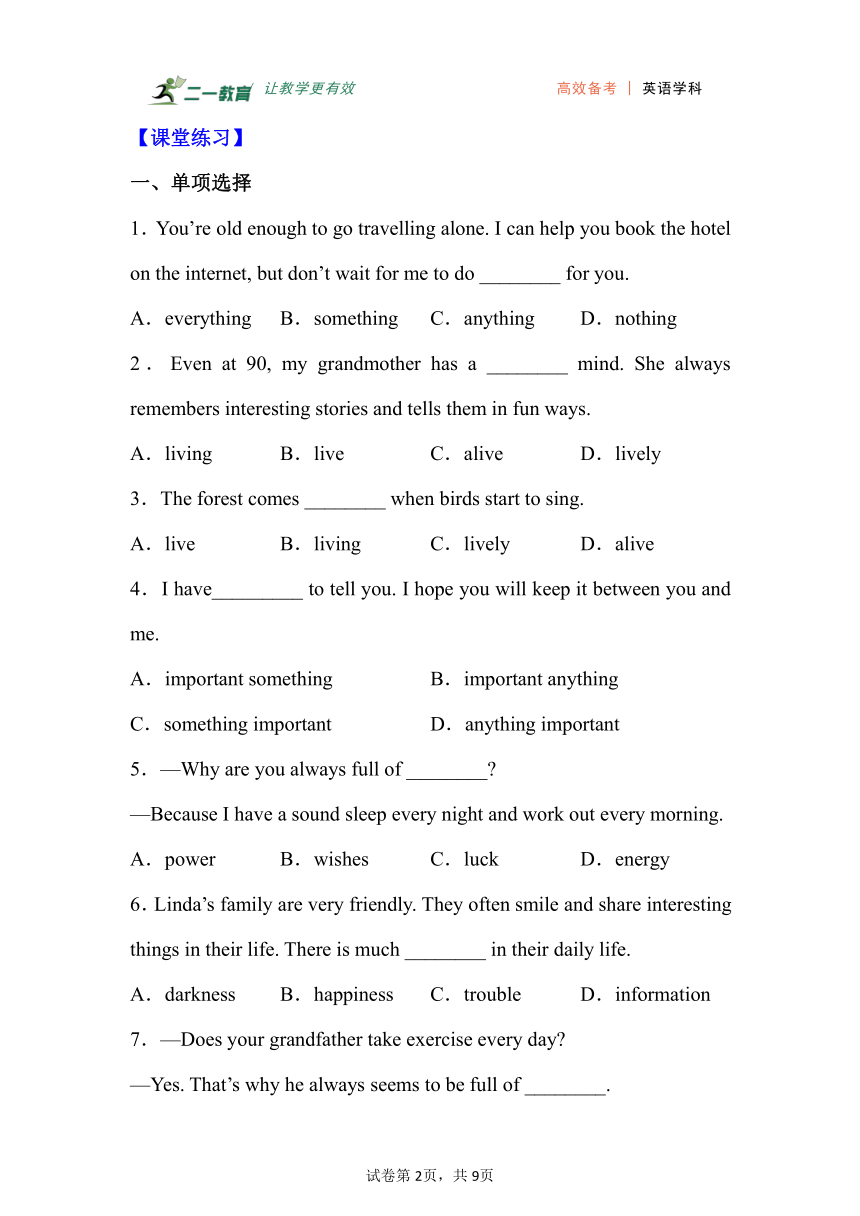
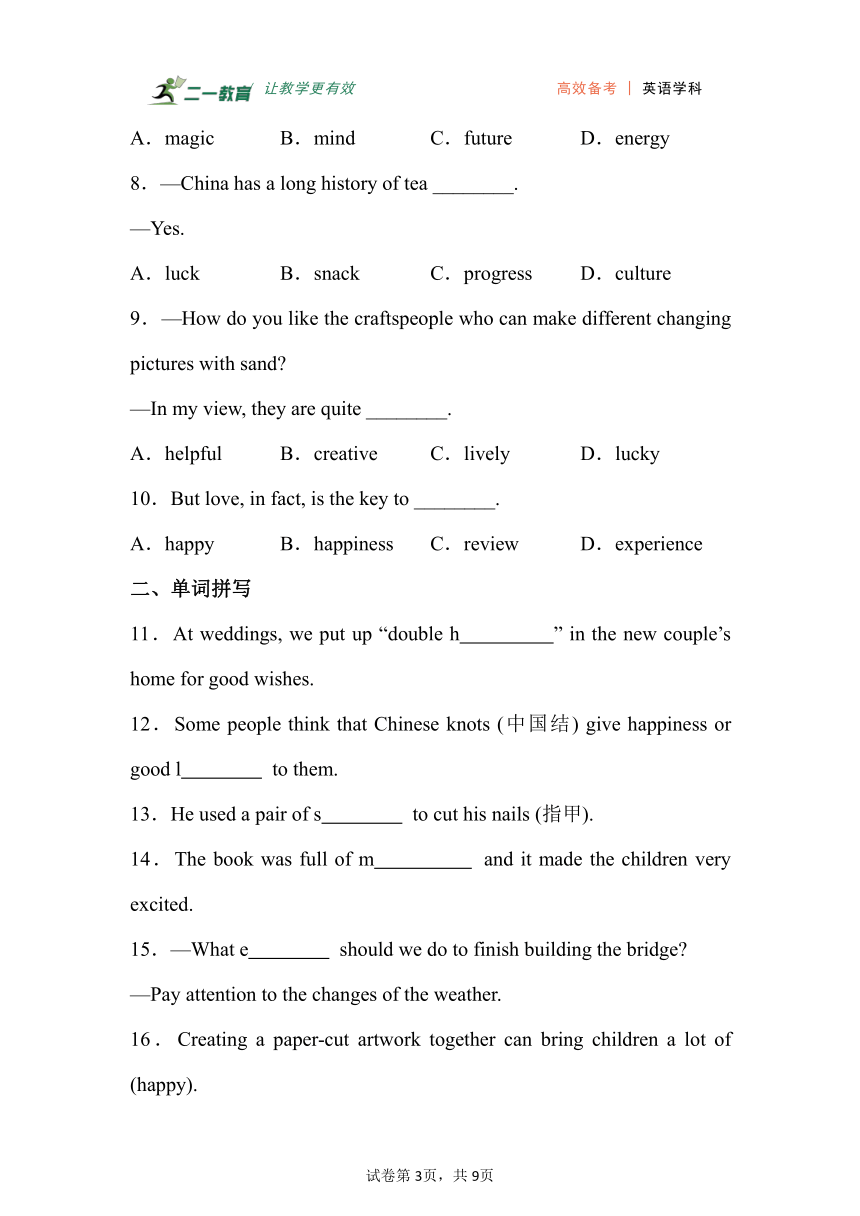
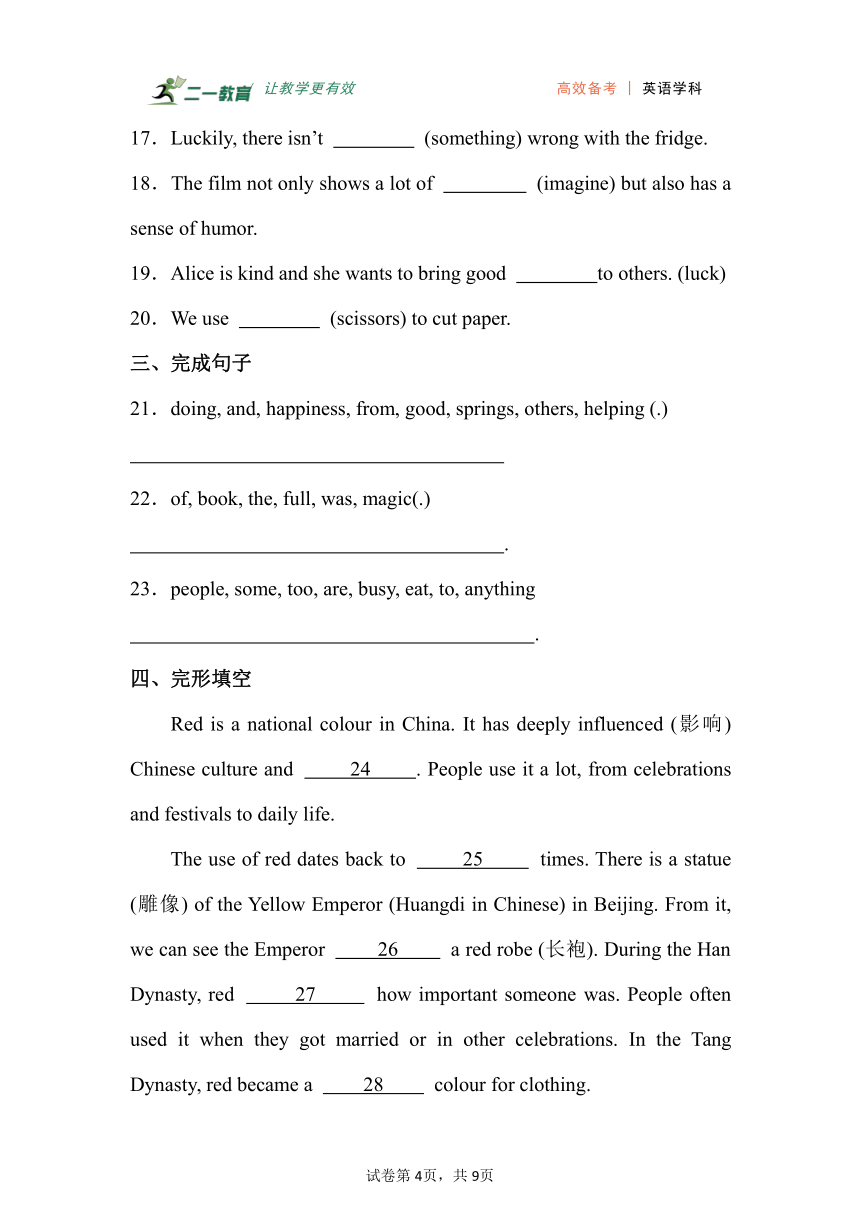
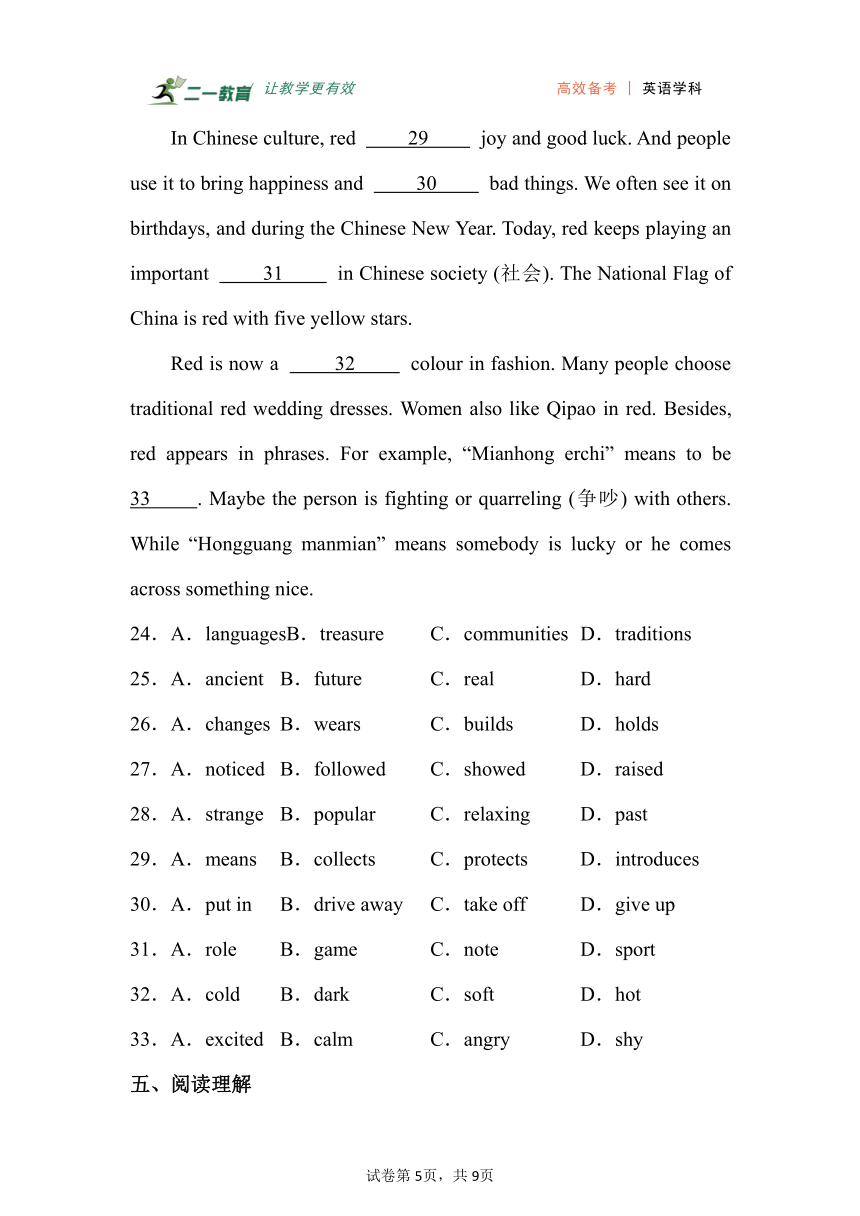
文档简介
/ 让教学更有效 高效备考 | 英语学科
Unit 6 Being creative
Lesson2 同步课时讲练
【课前预习】
单词英译汉
human(n):
Anything(pron):
Else(pron):
magic(adj):
Lively(adj):
Scissors(n):
paper-cut(n):
Luck(n):
Happiness(n):
Imagination(n):
短语翻译
paper cutting:
Turn into:
A pair of scissors:
Bring sb good luck:
In the coming year:
6.Art form:
【课堂练习】
一、单项选择
1.You’re old enough to go travelling alone. I can help you book the hotel on the internet, but don’t wait for me to do ________ for you.
A.everything B.something C.anything D.nothing
2.Even at 90, my grandmother has a ________ mind. She always remembers interesting stories and tells them in fun ways.
A.living B.live C.alive D.lively
3.The forest comes ________ when birds start to sing.
A.live B.living C.lively D.alive
4.I have_________ to tell you. I hope you will keep it between you and me.
A.important something B.important anything
C.something important D.anything important
5.—Why are you always full of ________
—Because I have a sound sleep every night and work out every morning.
A.power B.wishes C.luck D.energy
6.Linda’s family are very friendly. They often smile and share interesting things in their life. There is much ________ in their daily life.
A.darkness B.happiness C.trouble D.information
7.—Does your grandfather take exercise every day
—Yes. That’s why he always seems to be full of ________.
A.magic B.mind C.future D.energy
8.—China has a long history of tea ________.
—Yes.
A.luck B.snack C.progress D.culture
9.—How do you like the craftspeople who can make different changing pictures with sand
—In my view, they are quite ________.
A.helpful B.creative C.lively D.lucky
10.But love, in fact, is the key to ________.
A.happy B.happiness C.review D.experience
二、单词拼写
11.At weddings, we put up “double h ” in the new couple’s home for good wishes.
12.Some people think that Chinese knots (中国结) give happiness or good l to them.
13.He used a pair of s to cut his nails (指甲).
14.The book was full of m and it made the children very excited.
15.—What e should we do to finish building the bridge
—Pay attention to the changes of the weather.
16.Creating a paper-cut artwork together can bring children a lot of (happy).
17.Luckily, there isn’t (something) wrong with the fridge.
18.The film not only shows a lot of (imagine) but also has a sense of humor.
19.Alice is kind and she wants to bring good to others. (luck)
20.We use (scissors) to cut paper.
三、完成句子
21.doing, and, happiness, from, good, springs, others, helping (.)
22.of, book, the, full, was, magic(.)
.
23.people, some, too, are, busy, eat, to, anything
.
四、完形填空
Red is a national colour in China. It has deeply influenced (影响) Chinese culture and 24 . People use it a lot, from celebrations and festivals to daily life.
The use of red dates back to 25 times. There is a statue (雕像) of the Yellow Emperor (Huangdi in Chinese) in Beijing. From it, we can see the Emperor 26 a red robe (长袍). During the Han Dynasty, red 27 how important someone was. People often used it when they got married or in other celebrations. In the Tang Dynasty, red became a 28 colour for clothing.
In Chinese culture, red 29 joy and good luck. And people use it to bring happiness and 30 bad things. We often see it on birthdays, and during the Chinese New Year. Today, red keeps playing an important 31 in Chinese society (社会). The National Flag of China is red with five yellow stars.
Red is now a 32 colour in fashion. Many people choose traditional red wedding dresses. Women also like Qipao in red. Besides, red appears in phrases. For example, “Mianhong erchi” means to be 33 . Maybe the person is fighting or quarreling (争吵) with others. While “Hongguang manmian” means somebody is lucky or he comes across something nice.
24.A.languagesB.treasure C.communities D.traditions
25.A.ancient B.future C.real D.hard
26.A.changes B.wears C.builds D.holds
27.A.noticed B.followed C.showed D.raised
28.A.strange B.popular C.relaxing D.past
29.A.means B.collects C.protects D.introduces
30.A.put in B.drive away C.take off D.give up
31.A.role B.game C.note D.sport
32.A.cold B.dark C.soft D.hot
33.A.excited B.calm C.angry D.shy
五、阅读理解
①Zigong, in Sichuan Province is home to Chinese lanterns. Zigong’s lanterns are famous as the best lanterns in the world. The Zigong Lantern Festival dates back to the Tang Dynasty. In 2008, the Zigong Lantern Festival was listed as a national intangible cultural heritage (国家级非物质文化遗产) .
② “To make a big lantern for a show, makers need to finish 17 steps,” said Wan Songtao, an inheritor (传承人) of Zigong lantern-making skills. “Each step is done by a team, not just a maker.” For example, making a sundial (日晷) -shaped lantern took about 80 makers more than 50 days. With the help of modern technology (技术) like Al and holography, Zigong lanterns are special too.
③The lanterns can also show different themes. At the Zigong Lantern Festival, you might see a big panda lantern next to a Monkey King lantern, and you can find other cartoon characters. The rich themes of Zigong lanterns show the spirit of creativity and warmth from the local people’s heart.
④Now, the government encourages more local people to learn lantern-making skills. So far, Zigong lanterns have reached over 80 countries. Without doubt, we believe that they will be more and more popular in the future.
34.What can we infer (推断) from Paragraph 2
A.Holography is a kind of traditional technology
B.It’s hard for makers to make a big lantern for a show.
C.Zigong lanterns are the same as the lanterns in other places.
D.A maker can spend over 50 days finishing a sundial (日晷) -shaped lantern.
35.What’s Paragraph 3 mainly about
A.The rich themes of Zigong lanterns.
B.The long history of Zigong lanterns.
C.The great inheritors of Zigong lanterns.
D.The modern technology of Zigong lanterns
36.What does the underlined word “they” in Paragraph 4 refer to
A.People in Zigong.
B.Zigong lanterns.
C.The makers of Zigong lanterns.
D.Many museums.
37.How is the article organized (① Paragraph 1, ②-Paragraph 2...)
A. B.
C. D.
六、短文填空
阅读下面短文,在空白处填入1个适当的单词或括号内单词的正确形式。
The Zisha teapot, also called a “purple clay teapot,” is a special kind of teapot from China. It first appeared in Yixing, a city in Jiangsu Province, over 500 years ago during the Ming Dynasty. Today, it is still famous around the world for 38 (it) beauty and usefulness.
Zisha teapots are 39 (make) from an unusual clay called “zisha,” which means “purple sand”. This clay is rich in iron and minerals. When 40 clay is heated, it becomes hard and turns into dark red, brown, or purple colors. What makes these teapots special is that they are handmade by skilled craftsmen, 41 no two teapots are exactly the same!
People love Zisha teapots because they are great for making tea. The clay takes in the tea’s flavor 42 (quick). Over time, it makes each cup taste 43 (well). Also, the teapot’s tiny holes let air pass through, which keeps the tea warm 44 a long time without 45 (change) its taste. Many tea lovers say these teapots are like friends—they “grow” better with age!
In Chinese culture, Zisha teapots 46 (be) not just tools for tea. They are symbols of art and tradition. Some teapots are carved with beautiful designs, like bamboo, flowers or Chinese poems. People often give them as nice 47 (present) to show respect and friendship.
If you have a chance, look for one and enjoy the wonderful world of purple clay teapots!
/ 让教学更有效 高效备考 | 英语学科
试卷第1页,共3页
试卷第1页,共3页
【参考答案】
【课前预习】
一、1.人类 2.任何东西 3.其他的 4.魔法的5.生机勃勃 6.剪刀 7.剪纸 8.幸运 9.幸福 10.想象力
二、1.剪纸 2.转变成 3.一把剪刀 4.给某人带来好运 5.来年 6.艺术形式
【课堂练习】
1.A
2.D
3.D
4.C
5.D
6.B
7.D
8.D
9.B
10.B
11.(h)appiness
12.(l)uck
13.(s)cissors
14.(m)agic
15.(e)lse
16.happiness
17.anything
18.imagination
19.luck
20.scissors
21.Happiness springs from doing good and helping others
22.The book was full of magic
23.Some people are too busy to eat anything
24.D 25.A 26.B 27.C 28.B 29.A 30.B 31.A 32.D 33.C
34.B 35.A 36.B 37.C
38.its 39.made 40.the 41.so 42.quickly 43.better 44.for 45.changing 46.are 47.presents
Unit 6 Being creative
Lesson2 同步课时讲练
【课前预习】
单词英译汉
human(n):
Anything(pron):
Else(pron):
magic(adj):
Lively(adj):
Scissors(n):
paper-cut(n):
Luck(n):
Happiness(n):
Imagination(n):
短语翻译
paper cutting:
Turn into:
A pair of scissors:
Bring sb good luck:
In the coming year:
6.Art form:
【课堂练习】
一、单项选择
1.You’re old enough to go travelling alone. I can help you book the hotel on the internet, but don’t wait for me to do ________ for you.
A.everything B.something C.anything D.nothing
2.Even at 90, my grandmother has a ________ mind. She always remembers interesting stories and tells them in fun ways.
A.living B.live C.alive D.lively
3.The forest comes ________ when birds start to sing.
A.live B.living C.lively D.alive
4.I have_________ to tell you. I hope you will keep it between you and me.
A.important something B.important anything
C.something important D.anything important
5.—Why are you always full of ________
—Because I have a sound sleep every night and work out every morning.
A.power B.wishes C.luck D.energy
6.Linda’s family are very friendly. They often smile and share interesting things in their life. There is much ________ in their daily life.
A.darkness B.happiness C.trouble D.information
7.—Does your grandfather take exercise every day
—Yes. That’s why he always seems to be full of ________.
A.magic B.mind C.future D.energy
8.—China has a long history of tea ________.
—Yes.
A.luck B.snack C.progress D.culture
9.—How do you like the craftspeople who can make different changing pictures with sand
—In my view, they are quite ________.
A.helpful B.creative C.lively D.lucky
10.But love, in fact, is the key to ________.
A.happy B.happiness C.review D.experience
二、单词拼写
11.At weddings, we put up “double h ” in the new couple’s home for good wishes.
12.Some people think that Chinese knots (中国结) give happiness or good l to them.
13.He used a pair of s to cut his nails (指甲).
14.The book was full of m and it made the children very excited.
15.—What e should we do to finish building the bridge
—Pay attention to the changes of the weather.
16.Creating a paper-cut artwork together can bring children a lot of (happy).
17.Luckily, there isn’t (something) wrong with the fridge.
18.The film not only shows a lot of (imagine) but also has a sense of humor.
19.Alice is kind and she wants to bring good to others. (luck)
20.We use (scissors) to cut paper.
三、完成句子
21.doing, and, happiness, from, good, springs, others, helping (.)
22.of, book, the, full, was, magic(.)
.
23.people, some, too, are, busy, eat, to, anything
.
四、完形填空
Red is a national colour in China. It has deeply influenced (影响) Chinese culture and 24 . People use it a lot, from celebrations and festivals to daily life.
The use of red dates back to 25 times. There is a statue (雕像) of the Yellow Emperor (Huangdi in Chinese) in Beijing. From it, we can see the Emperor 26 a red robe (长袍). During the Han Dynasty, red 27 how important someone was. People often used it when they got married or in other celebrations. In the Tang Dynasty, red became a 28 colour for clothing.
In Chinese culture, red 29 joy and good luck. And people use it to bring happiness and 30 bad things. We often see it on birthdays, and during the Chinese New Year. Today, red keeps playing an important 31 in Chinese society (社会). The National Flag of China is red with five yellow stars.
Red is now a 32 colour in fashion. Many people choose traditional red wedding dresses. Women also like Qipao in red. Besides, red appears in phrases. For example, “Mianhong erchi” means to be 33 . Maybe the person is fighting or quarreling (争吵) with others. While “Hongguang manmian” means somebody is lucky or he comes across something nice.
24.A.languagesB.treasure C.communities D.traditions
25.A.ancient B.future C.real D.hard
26.A.changes B.wears C.builds D.holds
27.A.noticed B.followed C.showed D.raised
28.A.strange B.popular C.relaxing D.past
29.A.means B.collects C.protects D.introduces
30.A.put in B.drive away C.take off D.give up
31.A.role B.game C.note D.sport
32.A.cold B.dark C.soft D.hot
33.A.excited B.calm C.angry D.shy
五、阅读理解
①Zigong, in Sichuan Province is home to Chinese lanterns. Zigong’s lanterns are famous as the best lanterns in the world. The Zigong Lantern Festival dates back to the Tang Dynasty. In 2008, the Zigong Lantern Festival was listed as a national intangible cultural heritage (国家级非物质文化遗产) .
② “To make a big lantern for a show, makers need to finish 17 steps,” said Wan Songtao, an inheritor (传承人) of Zigong lantern-making skills. “Each step is done by a team, not just a maker.” For example, making a sundial (日晷) -shaped lantern took about 80 makers more than 50 days. With the help of modern technology (技术) like Al and holography, Zigong lanterns are special too.
③The lanterns can also show different themes. At the Zigong Lantern Festival, you might see a big panda lantern next to a Monkey King lantern, and you can find other cartoon characters. The rich themes of Zigong lanterns show the spirit of creativity and warmth from the local people’s heart.
④Now, the government encourages more local people to learn lantern-making skills. So far, Zigong lanterns have reached over 80 countries. Without doubt, we believe that they will be more and more popular in the future.
34.What can we infer (推断) from Paragraph 2
A.Holography is a kind of traditional technology
B.It’s hard for makers to make a big lantern for a show.
C.Zigong lanterns are the same as the lanterns in other places.
D.A maker can spend over 50 days finishing a sundial (日晷) -shaped lantern.
35.What’s Paragraph 3 mainly about
A.The rich themes of Zigong lanterns.
B.The long history of Zigong lanterns.
C.The great inheritors of Zigong lanterns.
D.The modern technology of Zigong lanterns
36.What does the underlined word “they” in Paragraph 4 refer to
A.People in Zigong.
B.Zigong lanterns.
C.The makers of Zigong lanterns.
D.Many museums.
37.How is the article organized (① Paragraph 1, ②-Paragraph 2...)
A. B.
C. D.
六、短文填空
阅读下面短文,在空白处填入1个适当的单词或括号内单词的正确形式。
The Zisha teapot, also called a “purple clay teapot,” is a special kind of teapot from China. It first appeared in Yixing, a city in Jiangsu Province, over 500 years ago during the Ming Dynasty. Today, it is still famous around the world for 38 (it) beauty and usefulness.
Zisha teapots are 39 (make) from an unusual clay called “zisha,” which means “purple sand”. This clay is rich in iron and minerals. When 40 clay is heated, it becomes hard and turns into dark red, brown, or purple colors. What makes these teapots special is that they are handmade by skilled craftsmen, 41 no two teapots are exactly the same!
People love Zisha teapots because they are great for making tea. The clay takes in the tea’s flavor 42 (quick). Over time, it makes each cup taste 43 (well). Also, the teapot’s tiny holes let air pass through, which keeps the tea warm 44 a long time without 45 (change) its taste. Many tea lovers say these teapots are like friends—they “grow” better with age!
In Chinese culture, Zisha teapots 46 (be) not just tools for tea. They are symbols of art and tradition. Some teapots are carved with beautiful designs, like bamboo, flowers or Chinese poems. People often give them as nice 47 (present) to show respect and friendship.
If you have a chance, look for one and enjoy the wonderful world of purple clay teapots!
/ 让教学更有效 高效备考 | 英语学科
试卷第1页,共3页
试卷第1页,共3页
【参考答案】
【课前预习】
一、1.人类 2.任何东西 3.其他的 4.魔法的5.生机勃勃 6.剪刀 7.剪纸 8.幸运 9.幸福 10.想象力
二、1.剪纸 2.转变成 3.一把剪刀 4.给某人带来好运 5.来年 6.艺术形式
【课堂练习】
1.A
2.D
3.D
4.C
5.D
6.B
7.D
8.D
9.B
10.B
11.(h)appiness
12.(l)uck
13.(s)cissors
14.(m)agic
15.(e)lse
16.happiness
17.anything
18.imagination
19.luck
20.scissors
21.Happiness springs from doing good and helping others
22.The book was full of magic
23.Some people are too busy to eat anything
24.D 25.A 26.B 27.C 28.B 29.A 30.B 31.A 32.D 33.C
34.B 35.A 36.B 37.C
38.its 39.made 40.the 41.so 42.quickly 43.better 44.for 45.changing 46.are 47.presents
同课章节目录
